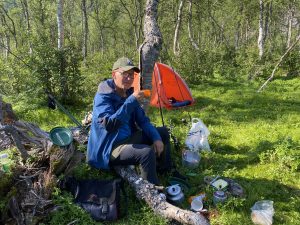My name is Vidar Bjørkli, I am 64 years old and live in Finnsnes, Troms in Norway.
I am married to Berit and have two grown up sons. Before my retirement two years ago I worked most of my life (nearly 40 years) as a journalist in the local newspaper Troms Folkeblad in Finnsnes.
In 2013 I experienced the first symptoms of dystonia. The diagnosis came one year later. Immediately I became a member of the Norwegian Dystonia Association (NDF), and it has been an enriching community to be a part of. During autumn 2019 I was asked if I wanted to become a member of the board. This is now my 5th year as a board member after I said yes to another two years at the last annual meeting.
As a board member in NDF I am responsible for Facebook, our webpage and our newsletter Dystoni-Nytt.
The symptoms came suddenly and unexpected as for most of us. From one hour of being healthy to the next hour having a chronic, incurable disorder. It happened when I was on my way home from the evening shift at my job in the newspaper one day in 2013. Suddenly I noticed that I was walking with my head turned to the left walking along the street.
I was really wondering what is this? I assumed that it was something muscular, maybe due to stress at work. I decided to see if a chiropractor could help. The chiropractor tried manipulation and acupuncture. Since this did not help he started to think that it could be something neurological. Online he found out that the symptoms could be dystonia. But my General Practitioner doubted that dystonia was the correct diagnosis. At the neurological department at UNN I was even denied an appointment for an examination. Instead they referred me for an examination at the department for medical physical rehabilitation. Their conclusion was that it would take time for this to pass and I should do yoga and exercise.
That was ok advice, but in the meantime the muscles continued to work overtime. It was also painful. Searching for answers on what could be wrong with me, I among other things wrote to the Norwegian Dystonia Association. They gave me valuable advice and tips.
I am a supporter of public healthcare, but a feeling of not being heard led me to contact a private hospital. Spring 2014 I had an appointment with a neurologist who worked at Volvat in Oslo. He did not need much time to determine I had cervical dystonia with torticollis towards the left.
After this it only took one month before I was referred for my first injections with botulinum toxin at UNN. I felt immediately that it relieved the stiff muscles and that it was easier to keep my head straight. Since then I have received treatments regularly every third month. Here I want to applaud UNN for continuity in the follow-up.
It was good to know that there is a patient organisation. At one meeting that NDF arranged in Tromsø I met with other members from Northern Norway.
As a new member I participated as a member with Berit at my side, the following years at Dystonia-days both in Oslo and Brüssel. We went privately and took it as a holiday.
It was liberating to join a group meeting where the participants shook their heads and to see that one is not alone. I was impressed to see the large number of experienced researchers, doctors and therapists that held presentations and continuously work to improve the treatment options for us who have this illness.
In the beginning I felt low because of having dystonia. I was somewhat embarrassed to be around people and thought now I am viewed as a weirdo. After some time this passed. The dystonia does not affect me anymore in the way I had feared. I could still work full time. Some of my dearest hobbies are to drive a motorcycle and to be in nature, go for fishing and mountain trips. I can still do this. Then I really relax and the dystonia is nearly absent.
Through the Norwegian Dystonia Association I have also had the chance to get acquainted with a lot of new nice people throughout Norway and abroad. So the diagnosis, no matter how bad it is, has also opened new exciting opportunities.
Vidar Bjørkli


